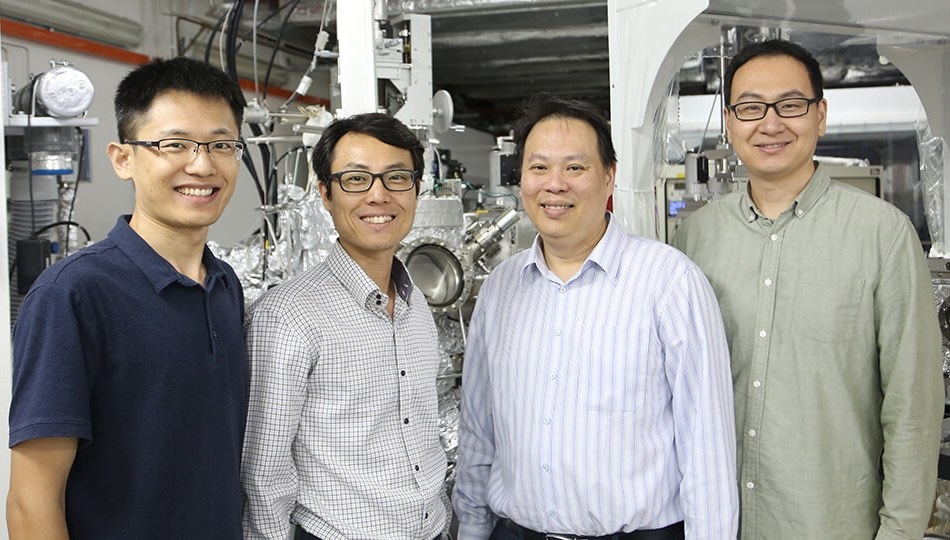Nov 29 2017
Realization of room temperature spin-orbit torque driven magnetization switching in topological insulator-ferromagnet heterostructures is considered to have promising applications in high integration density memories and logic devices and low power consumption.
 Researchers from NUS Engineering achieved a major breakthrough in spintronics research, which has promising applications in low power consumption and high integration density memories and logic devices. Credit: National University of Singapore
Researchers from NUS Engineering achieved a major breakthrough in spintronics research, which has promising applications in low power consumption and high integration density memories and logic devices. Credit: National University of Singapore
The current induced magnetization switching by spin-orbit torque (SOT) is a vital ingredient for contemporary non-volatile magnetic devices such as logic devices and magnetic random access memories that are essential for superior performance data storage and computing. In order to attain greatly efficient SOT driven magnetization switching, researchers from all over the world are actively searching for unique ways to decrease the existing high switching current density. Recently, researchers from the National University of Singapore (NUS) have made a major breakthrough in this field of research.
The NUS research team, headed by Associate Professor Yang Hyunsoo from the Department of Electrical and Computer Engineering, has for the first time, successfully demonstrated room temperature magnetization switching driven by giant SOTs in topological insulator/standard ferromagnet (Bi2Se3/NiFe) heterostructures with a very low current density, capable of addressing the issue of high power consumption and scalability needed in modern spintronic devices.
The finding of the study has been featured in the 8th November 2017 issue of the scientific journal Nature Communications.
Our findings can solve the fundamental obstacle of a high switching current in present heavy metal based SOT applications, and this is a big step towards room temperature topological insulator based spintronic device applications with ultralow power dissipation and high integration density. We believe our work will greatly invigorate topological insulator-based global research activities from diverse disciplines.
Associate Professor Yang Hyunsoo, The Department of Electrical and Computer Engineering
Using novel quantum matter: topological insulators
Topological insulators are electronic materials known to have a bulk band gap just like an ordinary insulator, but still continue to support conducting states on their surface, comprising of a robust spin-orbit coupling and spin-momentum-locked topological surface states (TSS), on which the electron momentum and spin polarization directions are powerfully locked.
Due to spin-momentum-locked properties, as charge current flows in the TSS, all electron spins will be fully polarized in a perpendicular direction to the direction of the moving electron. Therefore, a very high efficient spin current generation and thus a giant SOT efficiency are expected in topological insulators.
Dr Zhu Dapeng, Co-first Author of the study and a Research Fellow, The Department of Electrical and Computer Engineering
Taking advantage of TSS is vital for realizing high performance topological insulator based SOT devices. But, in typical topological insulators like Bi2Se3, the two dimensional electron gas and parasitic bulk states can wash out and/or contaminate the high SOT efficiency in TSS. The research team overcame this by identifying the TSS dominated SOT effect in ultrathin Bi2Se3 (≤ 8 nm), displaying a huge SOT efficiency up to 1.75 at room temperature, which is much bigger than the values of ~0.01–0.3 in heavy metals that have been conventionally used.
Superior performance topological insulator based devices for computing and data storage
In the standard heavy metal (such as Pt or Ta)/ferromagnet SOT devices, the current density needed for the magnetization switching still continues to be high, in the order of ~107–108 A/cm2, which deters their use in SOT applications of high performance.
The team proved the high efficient current induced magnetization switching at room temperature by employing topological insulator Bi2Se3 (8 nm), which is capable of being grown in a wafer scale by using molecular beam epitaxy (MBE), along with a standard 3D ferromagnet NiFe (6 nm), which is extensively utilized in different industries.
Our work successfully presents a significant reduction of switching current density for the magnetization switching by utilizing the giant SOT effect in Bi2Se3. The value is about 6×105 A/cm2, which is almost two orders of magnitude smaller than that of heavy metals. This is a major milestone for the ultralow power consumption and high integration density SOT device applications. Moreover, our devices work robustly at room temperature, which breakouts the limit of ultralow working temperature in previous TI device.
Dr Wang Yi, Co-first Author of the study
“Our magnetization switching scheme does not require an assistive magnetic field. This makes the topological insulator/ferromagnet material systems easy to integrate into the well-established industrial technology for magnetic devices,” added Associate Prof Yang.
Next steps
Moving forward, Associate Prof Yang and his team are performing experiments in order to further decrease the switching current by further refining the structures and materials of the systems, and they are also planning to integrate and test the technology in key magnetic memory devices. In order to further explore different applications with this novel material system, the team is hoping to work with industry partners.
A*STAR’s Pharos Program on Topological Insulators supported this research.